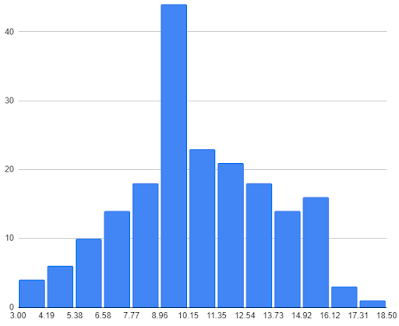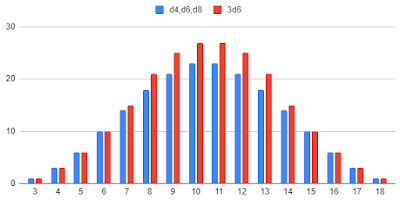In
past posts, I have discussed possible ways of pairing the 21 Tarot trumps with the 21 possible rolls of two dice, concluding in the end that the "Air Hexactys" system was the best. In this system, dice rolls are ranked first by total (e.g., any roll that totals 7 outranks any roll that totals 6); and then, among rolls with the same total, by the higher of the two numbers rolled (e.g., among rolls totaling 7, 1-6 outranks 2-5, which in turn outranks 3-4). The dice rolls, thus ranked from lowest to highest, were then paired with the trumps from 1 to 21. This system seems to "work" and to make symbolic sense, as briefly discussed in my post "
The root trumps of the Air Hexactys."
Now, the main reason for assuming a link between dice rolls and Tarot cards is the fact -- unlikely to be a coincidence -- that there are 21 possible rolls of two dice (2d6) and 56 possible rolls of three (3d6), corresponding precisely to the 21 trumps (the practice of numbering the Fool and counting it as a trump is a relatively recent development) and the 56 suit cards (Minor Arcana). The next step, therefore, is to try to find a dice-to-cards mapping that works for the Minor Arcana as well as the Air Hexactys works for the trumps.
Here are some of the challenges facing anyone who would attempt such a mapping:
⁂
Four suits: The trumps have a simple linear structure, being numbered from 1 to 21; all that is required is to establish a linear ranking of the dice rolls, which is not difficult. The Major Arcana, on the other hand, are organized in four suits. There is no obvious way to divide up the 56 possible rolls of 3d6 into four equal categories.
⁂
Rank within each suit: In most traditional games played with Tarot cards, the long/black suits (swords and clubs) are ranked, beginning with the lowest, A 2 3 4 5 6 7 8 9 10 J C Q K -- the same ranking used in most modern card games, except that aces are low. However, the round/red suits (cups and coins) rank the pips (but not the court cards) in reverse order: 10 9 8 7 6 5 4 3 2 A J C Q K. Although there are a few exceptions (most notably the French
jeu de tarot), I think we can take this idiosyncratic ranking system as a very old and probably original feature of the Tarot pack.
⁂
Relative rank of suits: Due to the quirk just mentioned, it seems that if we want to rank all 56 Minor Arcana linearly, we have to group them by suit first and then by rank within each suit. It wouldn't make sense, for example, to begin with the four aces, then the four deuces, and so on, because long aces are low but round aces are high. I suppose we could begin with the long aces and round tens, then the long deuces and round nines, etc., but this seems very unnatural.
The problem with ranking by suit first is that Tarot games do not rank the suits. Players must always either follow suit, play a trump, or discard a card. In no case can cards from two different suits be played in the same trick, so the question of whether, say, the King of Swords outranks the King of Clubs never arises.
Modern "esoteric" or divinatory tarot is not a trick-taking game, so "rank" as such is not an issue. Nevertheless, it has become customary to think of coins/pentacles as the "lowest" suit, followed by swords, then cups, and finally clubs/wands as the highest. Waite's chapters on the Minor Arcana in
The Pictorial Key to the Tarot, for example, begin with the King of Wands as the highest card and proceed down the ranks to the Ace of Wands; then the Cups, from King to Ace; then the Swords, and finally the Pentacles. (Waite makes tens high and aces low for all suits, contrary to the Continental tradition of which he was perhaps ignorant; Tarot has never been a
game in England.)
Historically, the four suits do have a natural rank, since they can be traced back to Chinese suits representing different denominations of money. Coins, which have preserved their character as single coins, are the lowest denomination. Next come Clubs, which were originally strings of 100 or 1000 coins. (Ancient Chinese coins had a hole in the center and were strung together.) Cups derive from the Chinese character for 10,000; and Swords, from the character for ten -- meaning, in context, ten
myriads, or 100,000. This ancient ranking has been preserved in many modern Anglo-French-suited games, where Spades (Swords; cf. Italian
spade) are the highest-ranking suit, followed by Hearts (Cups), Clubs, and finally Diamonds (Coins). (Bridge, in which Diamonds outrank Clubs, is an exception.)
⁂
Relation to trumps, especially root trumps: Because each of the trumps has been associated with a roll of 2d6, each roll of 3d6 will be associated with between one and three of the trumps. For example, the roll 1-4-6 would be associated with 1-4 (Lover), 1-6 (Hanged Man), and 4-6 (Sun) -- or, alternatively, with the three root trumps associated with 1, 4, and 6 -- namely, Magician, Death, and World. For rolls where the same number occurs three times, only one of the trumps will be linked; for example, 4-4-4 should be related to Death. (The Four of Swords would seem a natural choice for this roll.)
⁂
Sparse symbolism: Compared to the trumps, the Minor Arcana contain relatively little imagery. Prior to Waite's innovative "scenic pips," a card like the Seven of Swords portrayed nothing more nor less than seven swords (stylized as arcs in the Marseille tradition). Such cards have no immediately obvious meaning, and the traditional meanings ascribed to them vary widely. This makes it hard to judge whether or not a particular dice-card pairing is a "good" one. This can be viewed either as a bug (because it offers little guidance) or as a feature (because it allows the cards to accommodate a wide variety of systems).















